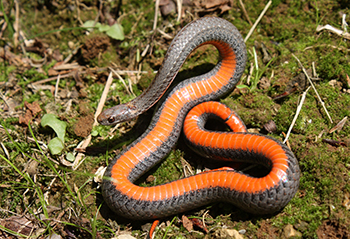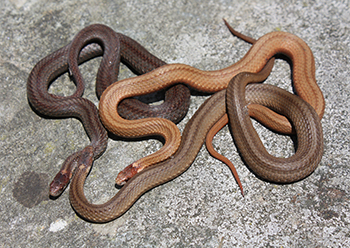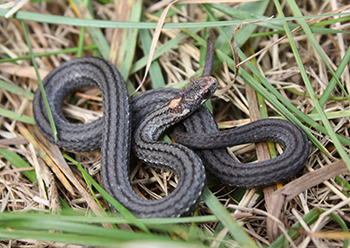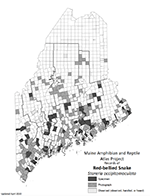Home → Fish & Wildlife → Wildlife → Species Information → Reptiles & Amphibians → Red-bellied Snake
Red-bellied Snake
Storeria occipitomaculata
On this page:

Photo: Trevor Persons
Distinguishing Characteristics

Photo: Trevor Persons
- Small, approximately 8 to 13 inches in length
- Brown, reddish-brown, or gray above with two parallel rows of darker brown stripes along center of back
- Three light tan spots behind head, one behind each ear and one on neck; in young, fused to form tan-colored band around neck
- Underside bright red or orange, occasionally yellow or even black
- Dorsal scales keeled (longitudinal raised ridge along midline of each scale)
- May be confused with ring-necked snake or Dekay’s brownsnake
Status and Distribution in Maine
- Common and secure
- Statewide, but may be absent from northernmost Maine
Habitat

Photo: Trevor Persons
- Forested uplands, fields, old buildings, gardens, and rock outcrops
- Commonly found under rocks, logs, boards, and debris piles
Diet
- Slugs are a preferred prey item
Seasonal Changes
- Often hibernates in large aggregations underground; one researcher found over 100 snakes within a single anthill. Also hibernates in stone walls, rock crevices, and rodent burrows
Natural History Notes
- Gives birth to live young from June through September
- Rarely bites when handled, but releases musky discharge
Share Your Sighting
There is much still to learn about the distribution and ecology of Maine’s herpetofauna, and we encourage members of the public to share their photo-documented observations as part of the Maine Amphibian & Reptile Atlas Project (MARAP).
To see if a township still needs documentation of a species, consult this distribution map (PDF). If a township lacks a photo or specimen record, we want your observation!
There are two ways to share your observations:
Submit your reptile or amphibian observation online
No service? No problem. Click here to download the survey to your device while connected, then take offline to collect observations from anywhere. Tip: The survey works best on Google Chrome and Safari.
Or upload sightings to the iNaturalist citizen science project through their website at iNaturalist.org or mobile app.
- When submitting an observation through iNaturalist add a description of the location (and other noteworthy information) to the “notes” field. This serves as a check on the locations automatically generated by smartphone cameras, which may be imprecise if cell service or GPS coverage is weak.
Thank you for doing your part to help conserve Maine’s reptiles and amphibians.
